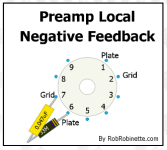Mike McLane
Active member
No. . .not THAT kind of negative feedback. . . . the "amp" kind. I've been tinkering with the Ambassador to mod as a straight-up preamp. . . both as a DC30 and a '59 Bassman clone. The '59 has a Presence control (variable negative feedback) and as I dug around I noticed that many amps, even the blackface Fenders (a la the Particle Accelerator) have a negative feedback circuit in them. There IS a way to incorporate NFB in a preamp circuit and I wondered if you've ever delved into it and what conclusions you may have come up with.


